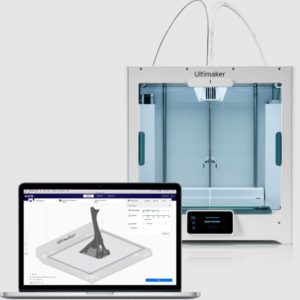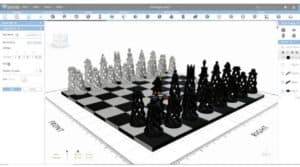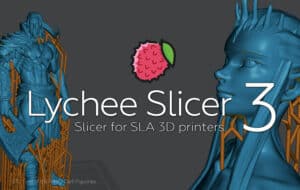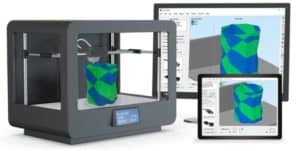Best 3D Printing Software
All 3D prints begin as models created on 3D modeling software. We’re fortunate enough that nowadays there’s a wide range of modeling software out there, that is often cheap, or even free. Some of the below-listed software is targeted for entry-level users, looking for something cheap and user-friendly to get them into the world of 3D printing. We will, however, list some more advanced software, targeted at more professional use. Here’s what we came up with.
Products at a Glance
How we picked the best 3D printing software
When considering the best 3D printing software currently out there on the market, we wanted to select the best for both beginner and professional use. It was important for us to list products that score highly in usability, whilst also retaining advanced features to ensure users had complete control over their pritns.
Product Reviews
- Open source
- Great interface
- Slightly outdated graphics
Cura is a great, open-source 3D printing software developed by Ultimaker specifically for their own 3D printers. However thankfully, it can be used with most other 3D printers with little difficulty, making it a global standard. With Cura, users can create 3D models from scratch or import existing models off the web. Once a model is created, Cura can be used to generate a sliced model, which can then be exported as an STL file.
Cura also offers a wide range of settings that can be used during 3D printing process, such as adjusting layer height and infill percentage. Cura is a great bit of 3D printing software that gives users total control over their 3D printing process. It is for this reason that Cura sits in the top place on our list of the best 3D printing software out there.
- Solid free option
- Great rendering
- Not completely free
SelfCAD is a fantastic user-friendly 3D printing design software, suited for both beginners and more advanced printers. SelfCAD’s fantastic slicer is compatible with the most widely used FDM 3D printers. SelfCAD also features a brilliant 3D rendering function. Users can generate realistic 3D renders using its in-built 3D rendering engine, adding lighting, textures, materials, and colors to their designs.
If you have STL files that you would like to modify, you can also do it easily within SelfCAD. For example, the Simplify 3D tool that reduces the number of faces in the STL file before sending it for 3D rendering or animation – is particularly useful. Overall, SelfCAD is a leading bit of software and is easily one of the best bits of 3D printing software out there.
- Great interface
- "Magic" automation
- Not free
Lychee Slicer is a great choice for 3D resin printing, offering a vast selection of 3D printers and resin profiles. The Lychee SLicer is also incredibly user-friendly, easy to use, and has generally great features.
The Lychee Sliver’s “Magic” button is a great feature for users looking to get stuck right in. In the Magic mode, the Lychee slicer takes care of everything, including automatic model orientation. This can assist beginners massively, and let them create great results within minutes.
- Highly proffessional
- High degree of manual control
- Expensive
Simplify3D is packed with great features that make it appealing to many advanced users. For example, Simplify3D allows users to combine multiple printing processes into a single g-code file. Features like this are targeted at more advanced users, so if you are an advanced printer who wants complete control over your prints, then Simplify3D is your best bet.
Simplify3D prioritizes functionality over a sleek and intuitive design, unlike many of the other software on this list. The interface may seem quite complicated to a lot of beginners, but advanced users that can see past the interface won’t struggle with this at all. your users that seek complete control over their prints, do not mind spending money on high-quality software, then Simplify3D should be your software of choice. Professional users will like the degree of manual control they can obtain, and should definitely think about Simplify3D.
Things to consider when choosing the best 3D printing software
User Interface
A solid user interface is important for all software. This might be less of a concern for those of you who are already well-seasoned 3D designers, but for beginners looking to get into the field, easy-to-use software is very important.
Price
For beginners, we’re glad to say that there’s a wide range of free, open-source software out there for those of you looking to get started. However, more advanced, professional software can come at a hefty price. It is important to consider how much you are willing to spend, when choosing the best 3D printing software.
What Is 3D Printing Software?
3D printing software converts and makes 3D model instructions understandable for a 3D printer‘s use so that it can create different physical objects in a layer-by-layer form. The set of instructions it makes includes the printer’s nozzle path to follow, the placement and the amount of material, and the speed or the temperature.
Is Cura free?
Yes, Cura is a free, open-source software compatible with a wide and continuously growing range of 3D printers.
How much is 3D printing software?
3D printing software ranges in price. Lots of free software is available. However, for more advanced purposes, paid for softwaresoftware can start from anywhere under $100 to under $500.
Our Verdict
Cura is a great, open-source 3D printing software developed by Ultimaker specifically for their own 3D printers. However thankfully, it can be used with most other 3D printers with little difficulty, making it a global standard. With Cura, users can create 3D models from scratch or import existing models off the web. Once a model is created, Cura can be used to generate a sliced model, which can then be exported as an STL file.





